Delivering a one-ton load to the 25th floor - made possible by the RAF's 28 Squadron
Primary tabs
In April 1972, Gordon Andreassend was sitting in his office in Murray Building when Hal Empson, the Cartographer strode in. “We’ve got a problem with the process camera” he said.
“Everything’s arrived, hasn’t it, what’s the problem?” was Gordon’s reply.
It appeared there seemed no way to get the solid metal base of the camera, weighing about one ton, and 20 foot in length, into its allocated space on top of the building. It was too big for any lift, and too heavy to manhandle up the stairs to the 25th floor.
Murray Building had been completed in 1970, and was the HQ and home to several offices of the Public Works Department (PWD). There was no external hoist fitted to the building to haul up a heavy load.
The Crown Lands and Survey Office, (CL&SO) responsible for all land transactions, planning and for survey and mapping of the territory, was one of those offices, located at the top of the building. Since 1968 CL&SO had been tasked with taking over the production of all coloured topographical maps of Hong Kong, and the use of the process camera was an essential element in that undertaking.
Gordon had been working in the PWD as a Land Surveyor since 1966, when two untimely deaths of first a Draughtsman, then a Land Surveyor, led to his reluctant appointment to the new post of Cartographer in 1968. He arrived just in time to be told by the Colonel in charge of Military Mapping in Hong Kong that they would no longer be publishing coloured topographical maps of Hong Kong. The reason for this was that the UK was removing all military personnel from Singapore and transferring all local defence requirements to the Singapore government, due to the establishment of the Republic in 1966. This meant the closure of their Far East map printing unit, and hence, no more printed maps of Hong Kong from that source.
This news came as a bit of shock to the Head of the Survey Office, but he immediately requested Gordon to arrange for the training of suitable staff to perform mapping tasks, as top priority. Seven or eight experienced staff were selected to be sent overseas to gain experience. This was well under way when Gordon handed over to Hal in 1969 as the incoming Cartographer, with years of experience in the Ordinance Survey in the U.K. Hal spent most of 1971 arranging the purchase of the badly needed process camera.
Gordon had returned to his original post as a Land Surveyor, and by 1972 promoted to Senior Land Surveyor, was dealing with survey control, mainly in the form of trigonometrical survey stations throughout the territory. He also had a part-time job working as the aerial surveyor, taking aerial photography in the twin-engined Britten-Norman Islander, of the Auxiliary Air Force (RHKAAF).
Hal had approached Gordon to ask if the RHKAAF could assist in lifting the camera base to the top of the building. They had four Allouette helicopters at that time, and Gordon doubted they would be able to perform this task, but said he would enquire that day, as he was going to their base at Kai Tak to prepare for an air survey sortie.
On arrival he went to see Ft. Lt. John Shawcross, and asked if the Allouette would be up to this task. John, a fixed wing and rotary pilot, and the Adjutant of the unit was from Yorkshire, and fairly direct with his comments. “No way, you need a more powerful helicopter than ours” he said.
Seeing the look on Gordon’s face, he smiled, and went on - “But you may be in luck- the RAF are changing their Whirlwinds for Wessex helicopters, and they can lift that weight.”
Looking at his telephone, he said, “I’ll give them a tinkle”. Soon he was talking to someone in 28 Squadron, and it was confirmed that an official request from the CL&SO would be favourably considered.
Hal was delighted, as a major delivery hurdle had been removed. The next day, following discussion with the CL&SO boss, and the head of maintenance in Murray Building, Gordon was tasked with drafting a letter to be sent to CRAF (Commander RAF) from the Director, and for letters to be prepared for dispatch to the Anglican Cathedral and the GM of the Hilton Hotel. It had been decided that Sunday morning was the best time for the operation, and it was considered wise to advise Murray Building’s nearest neighbours of this operation.
The PWD was able to close the adjacent public car park on Sunday for a couple of hours in the morning. The load would be delivered there and the Wessex crew would prepare for a lift from the car park. A plan of the car park and building and details of the location of the light well on the roof of the building was prepared and sent to 28 Squadron. The load had to be lowered into the opening for the light well, then swung to a diagonal position and lowered down to get past a horizontal cross beam. The space was quite tight.
With the paper work completed, and the date fixed, all was ready for the lift.
At 28 Sqn the details of the proposed lift had been received with great interest as it did seem a practical task. However, the Officer Commanding, Sqn Ldr John Puckering, and the pilot who would fly the aircraft for the job, Flt Lt Bob Turner, agreed that a recce of the location was needed, so this was flown on 9 May and resulted in a detailed plan for the lift being put together. The area around the Murray Building was heavily congested, so normally the flight would conflict with several flight safety rules. However, as the Wessex was a twin-engine aircraft, the Civil Aviation Dept took this safety factor into account and authorized the operation.
On Sunday the 14th of May, Bob, with 3 experienced helicopter crewmen (Sgt Bob Bickers, Flt Sgt Geoff Costello and Sgt Nigel Cole) flew across the harbour from RAF Kai Tak to the Garden Road car park in the Central District of Hong Kong Island, which was adjacent to Murray Building, and landed near the prepositioned crate containing the camera base.
Gordon met the crew, a detailed briefing was held and a thorough check made of the rigging chains and their attachments.
When all was ready the aircraft started up, took off, and moved over the load to be lifted so that it could be attached. An 8 ft webbing strop was used between the lifting chains and the aircraft’s underslung load hook.
With directions from Sgt Bickers in the rear cabin of the Wessex, the crate was lifted gently off the ground and the aircraft climbed vertically up the side of the building.
The two Rolls-Royce Gnome engines of the Wessex Mk 2 provided more that enough power to cope with the 2,000lb weight of the load. Once the aircraft was above the level of the building roof, it was slowly moved across until hovering with the load over the light well.
For the pilot, this was probably the trickiest part of the operation. Despite poor visual references, a really steady hover was needed to stabilize the rotation of the crate in the right position, before slowly lowering it down. Getting it aligned diagonally across the area was essential for it to fit but the two other crewmen had rapidly gone up to the top floor ready to steady and ‘steer’ the crate using chains hanging from each end of the load as it was lowered.
Once in position over the wooden bed, the crate was lowered the last few inches and, once the lifting strop and chains had slackened, the load was released to complete the lift.
After picking up the other crew members, Bob and his crew flew back to Kai Tak and took the rest of Sunday off! A very satisfying morning’s work.
As the Wessex and its load moved up the side of Murray Building, Gordon headed for the lifts to the top of the building – he wanted to see the arrival. From the top floor he raced up the stairs to the roof and saw an amazing sight of the Wessex hovering rock steady over the light well. The enormous machine seemed so close to structures on the roof. His heart stopped though when saw the load revolving at about 10 rpm (it seemed), and he wondered how the crew could stop that motion in order to lower the crate down. Stop it they did, however, and he shot downstairs to the room next to the lightwell to see two of the crewmen guiding the crate gently onto the wooden bed that had been prepared for it. A soft landing and a job well done.
A happy celebration
All were pleased with the outcome, and Gordon, with the blessing of the CL&SO Director, Tubby Crunden, was asked to stand the crew of the Wessex a night out in Kowloon. He readily agreed, as the office would pick up the tab.
Hal and Gordon arranged to meet with the Wessex crew, Fl Lt Bob Turner, Sgt Bob Bickers, Sgt Nigel Cole, and Flt Sgt Geoff Costello, in a Tsim Sha Tsui restaurant. A convivial gathering was celebrated in recognition of a most professional piece of work, done in such a prompt and excellent manner. Thank you 28 Squadron, RAF.
Thank you to Gordon Andreassend for his guest post in this week's newsletter.
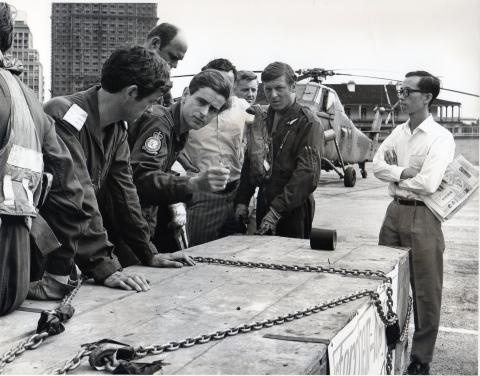
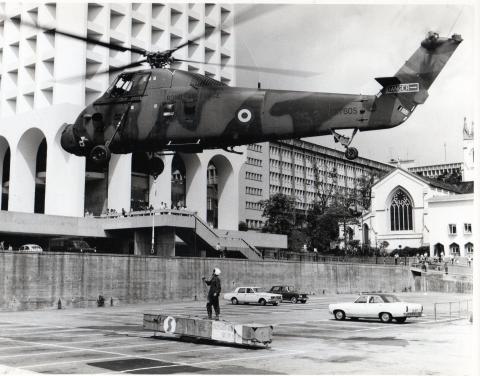
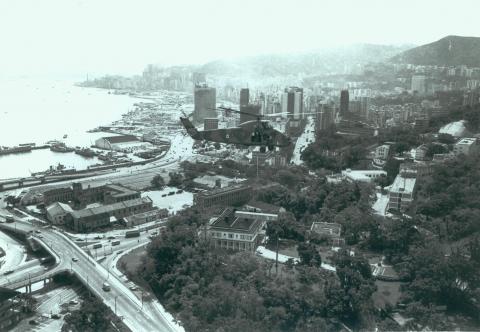
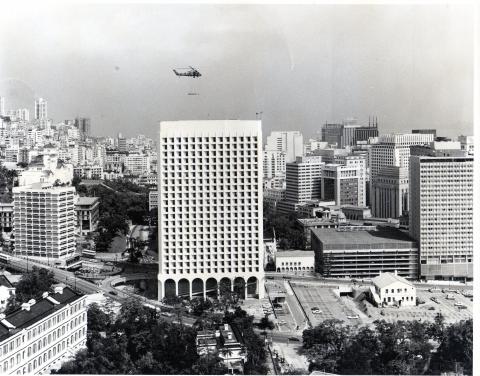
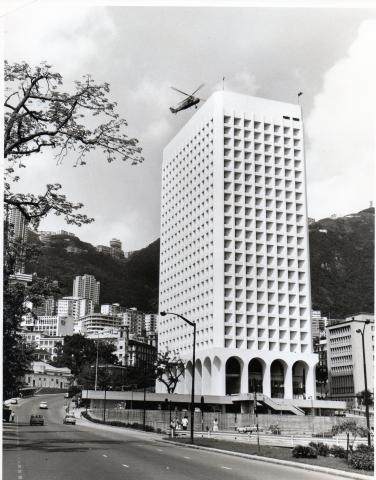
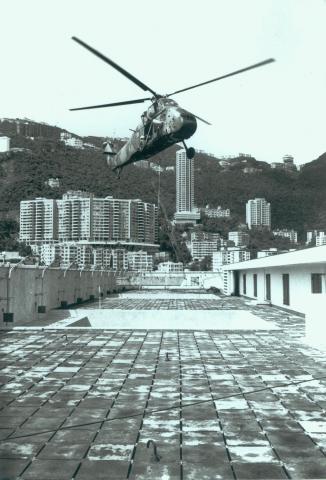
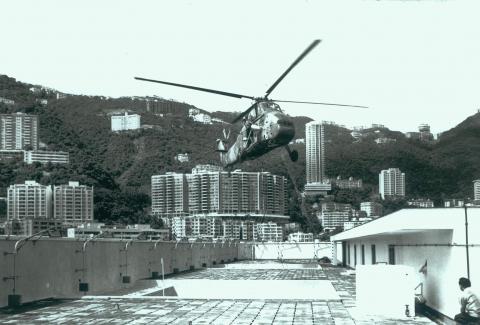
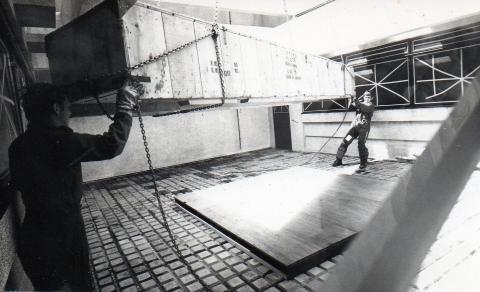
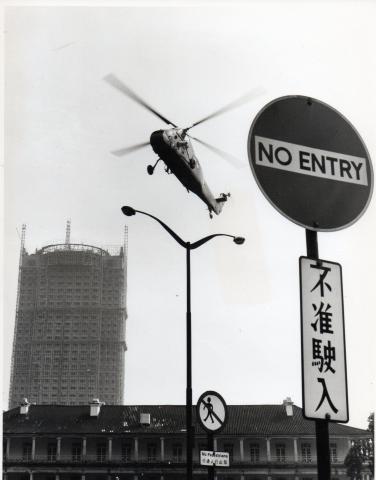

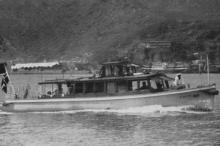
Good Read
Great story. Nice pics. Good to see the ironhorse of 28 Squadron.
a fascinating read about gordon andreassend
the bells rang in my head as soon as i saw the name gordon andreassend, for he is an acquaintance of my brother who (like myself) is an Auckland Grammar School old boy and he had the pleasure of meeting the great Gordon at one of the Alumni meets a couple of years ago. sounds like he is a man with many more stories to tell! thanks for posting!
Murray Building recollections
That was a really interesting account. My late father, Phil Roberts, worked as a valuer in the Lease Renewal department of the CLSO, firstly in the Central Government Offices over the road, and then in a nice corner office high up in Murray Building overlooking the Peak Tram station. I used to call in there every afternoon on my way home from KGV, doing my homework in my dad's secretary's office, until it was time to go home. I'm livid that he didn't tell me about this helicopter operation - I would have loved to have seen it.
The mention of Tubby Crunden brought back memories. I only ever saw him on social occasions, when I was quite young, but my recollection is of an ebullient character, often well-oiled. I was envious of his lovely flat in Peak Mansions and of his two gorgeous Samoyed dogs. HIs wife Des, was also a larger-than-life figure. Thanks for stirring up almost-forgotten memories.
@ Sgt Bob Bickers
Sgt Bob Bickers must surely be the father of Dr. Robert Bickers ? Robert, in his book "Empire Made Me" , writes about his father serving in the RAF at Hong Kong during this era and that he worked on helicopters.
Robert Bickers, currently Professor of History at the University of Bristol, is well-known in various Hong Kong history circles and directs the Hong Kong History Project.
Gordon
Great story from Gordon.
One if the unsung people in HK who used their ingenuity and got things done.